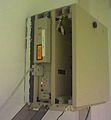Network termination
As network termination (English N etwork T ermination, NT ) is referred to in the telecommunications the point at which a terminal access to a communication network is provided.
Tasks / characteristics
Because the network termination is part of the network, unlike connected end devices, remote maintenance functions are built in with which the network operator can check the functionality .
The network termination is also the point at which the responsibility of the network operator for the contractual operability ceases. Malfunctions on the subscriber side of the network termination point are the responsibility of the subscriber.
In networks in which, as in the telephone network, switching or routing takes place, the network termination point is designated with a specific network address which can be linked to the telephone number or the name of a subscriber.
Network termination types
Analog subscriber connection
The network termination of an analog subscriber line is called NTA (Network Termination of analog subscriber line).
Since the liberalization of the terminal equipment market through the postal reform in 1989, telephone subscribers have been able to connect terminal equipment (e.g. telephone , fax , etc.) to the telephone network on their own responsibility . The network operator's NTA forms the so-called " 1st junction box" with the built-in passive test termination . In the past, the network was terminated by the devices connected to the connector (VDo) or junction box (ADo) themselves.
ISDN
With ISDN , the devices NTBA and NTPM form the network termination. The sockets of these devices are the termination point of the ISDN.
NT types
- the network termination for the ISDN basic connection : NTBA
- the network termination for the ISDN primary rate connection : NTPM , whereby a distinction must be made between the network termination with fiber optic connection (NTPM GF ) and that with copper connection (NTPM KU ), and
- the bilingual network termination for the ISDN basic connection NTBIBA ( N etwork T ermination for Bi lingual B asic A ccess), via which terminal devices of the 1TR6 -ISDN can be operated on a Euro-ISDN connection ( DSS1 ) .
The most important task of the ISDN-NT is to implement the technical transmission interface between the U and S reference points ( U K0 and S 0 for the basic access, U K2 and S 2M for the primary rate access). With the bus- shaped ISDN basic connection, the network termination also coordinates the access of the terminal devices.
Explanation of terms
- S 0 = subscriber-side interface for basic access
- S 2M = subscriber-side interface for primary rate access
- U K0 = network-side interface for basic connection
- U K2 = network-side interface for primary rate connection
Optical access networks
In the case of optical connection lines , the optical network unit is the network termination.
Next Generation Network (NGN) / data connection
Data connections usually have a modem (usually a DSL modem or cable modem ) as network termination; NGN connections based on this use an Integrated Access Device for network termination; In the case of asymmetrical T-DSL connections from Deutsche Telekom , the DSL modem according to the U-R2 standard is the responsibility of the subscriber and the splitter represents the contractual network agreement.
Cellular
In mobile radio , the radio interface between the mobile radio transmitter and mobile station forms the network termination together with the SIM card .
Dedicated line
There are also network termination points for leased lines and other connecting routes.
literature
- Dieter Conrads: Telecommunications. Basics - Procedures - Networks, 5th corrected edition, Vieweg + Teubner Verlag, Wiesbaden 2004, ISBN 3-528-44589-0 .
- Torsten Schulz: ISDN on the computer. Springer Verlag, Berlin / Heidelberg 1998, ISBN 978-3-540-62783-8 .
- Wolf-Dieter Haaß: Handbook of the communication networks. Introduction to the basics and methods of communication networks. Springer, Berlin Heidelberg 1997, ISBN 3-540-61837-6 .
- Rudolf Nocker: Digital Communication Systems 2nd 1st edition, Friedrich Vieweg & Sohn Verlag, Wiesbaden 2005, ISBN 978-3-528-03977-6 .
Individual evidence
- ↑ 1 TR 110-1 Technical description of the analog dial-up connections on the T-Net / ISDN of the T-Com (PDF; 1 MB) ( Memento of the original dated December 8, 2015 in the Internet Archive ) Info: The archive link was inserted automatically and not yet checked. Please check the original and archive link according to the instructions and then remove this notice. Edition: October 2015, Deutsche Telekom AG, Darmstadt.

